Russ Blood Photographs
As we get further along with relating the history,
we will be able to show a better picture of the operation and that it was a
successful business. I can only speculate on why any official account may not
have the complete story. It is important to show that this worked and was a
good part of the transportation links of this area and Alaska. Freight arrived
not only for Valdez, but also for destinations farther north - Fairbanks and
other locations. I have been told by a good source, that at times there were
three barges a week. There was also some backhaul, as able to acquire. It was
in operation from 1965 to some time in 1978 I think. I'll have to do more research
on the latter year. Pipeline construction began very late in 1973, if I recall,
and continued through 1977.
I haven't found a lot but here are some pics
to get started. I think the yard began operations in Sept. 1965 with the Crowley
barge ''Birch" and tugboats Titan, Trojan, and possibly Champion, [at various
times] providing the link between Whittier and Valdez. I have seen reference
to "several hundred railcars" handled by the Valdez rail yard, and
this was PRE - Pipeline. As I get more info it probably won't be in any order,
so please bear with us.
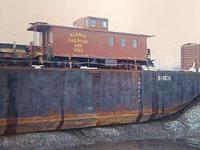 |
Photo of first rail barge arrival. I believe Sept of 1965
with equipment to install dolphins and other pieces. |
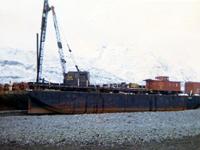 |
Photo of first rail barge arrival. I believe Sept of 1965
with equipment to install dolphins and other pieces. |
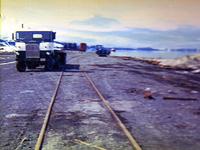 |
Barge at landing. Looking from about mid yard.
Whiting Switcher at about 2nd switch. This photo about 1967-69. Truck is
mid to late '50s White Freightliner,
somewhat unique as it was equipped with front drive axle making it 4x4.
220 Cummins and 10 speed RR believe ex-CF. Two of these trucks were acquired
to handle chassis's and other work. |
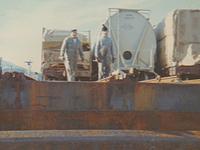 |
Barge arrival, about 1966-67. It shows two flats and bulk cement car. |
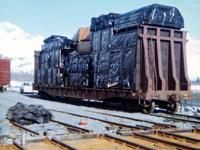 |
Showing barge and track and short
sections of connecting rail. I believe cargo on flatcar is pre- fab split
level home. Photo about
1965-67? |
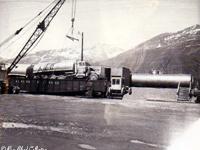 |
Loading damaged tank truck for
shipment to Seattle for repair. About 1970. Truck is late '60s Kenworth
with four axles and V12-71 Detroit
Diesel. Part of small fleet that hauled fuel from Valdez, north to Copper
Center, Delta, Tok, and Fairbanks. If you are wondering
why the tank truck was being loaded into a gondola, my recollection is that
it needed to leave on the next barge and there were no empty flatcars in
the yard. Because no ramp was installed the barge had to be worked according
to the tide, so it was usually necessary to unload and reload the barge in
a short amount of time. |
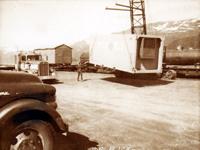 |
Early container handling. I think first van is 24 or 27' long. Reefer
unit belonging to Alaska Line. Crane is a P & H Serial # 6817, purchased
from Alaska Railroad. Photo about 1968-69. |
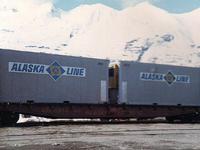 |
This photo about 1967-69. I think these containers belonged to Alaska
Steamship Co. and were 24 or 27' long- General Cargo. |
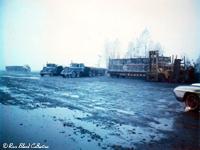 |
This photo is Sept/Oct 1965 I think. In left background shows original
prime mover for moving cars, prior to receiving Whiting trackmobile. Rhis
was some type of large aircraft tow trailer, possibly USAF surplus. |
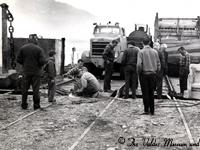 |
[Added 3/9/07] These two photos
are very good. I think several of the people shown are listed in the News-Miner
article. This shows the
first
prime
mover? in good detail. So far I haven't found much information on it other
than it was some type of aircraft tow tractor. (Photo by Don Teeters) |
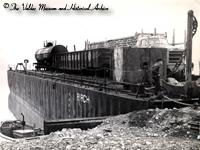 |
[Added 3/9/07] These two photos are very good.
I think several of the people shown are listed in the News-Miner article.
This shows the first prime
mover? in good detail. So far I haven't found much information on it other
than it was some type of aircraft tow tractor. (Photo by Don Teeters) |
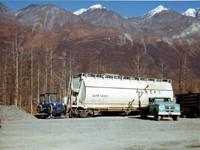 |
[Added 3/9/07] This picture shows one of the
cement cars and was taken in the upper quarter of the yard, near where
the yard met the road. I think the gondola next to it is up against the
loading ramp. |
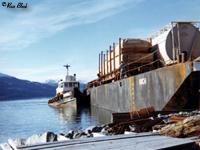 |
[Added 3/9/07] Shows barge arrival. The picture
of the tug alongside the barge maybe 1966/67. I'm not able to I.D. which
tug it was. Some of the debris shown on the rocks was probably left by
a high tide. I think the short pieces of rail shown may have been one. |
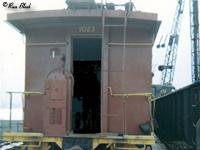 |
[Added 3/9/07] This is interesting as it shows
the number and how the cars were secured. Notice the chocks & stabilizers?
1966 |
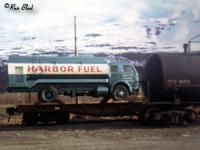 |
[Added 3/9/07] This is a mid to late 50's White
3000 series for my father's fuel company Harbor Fuel. |
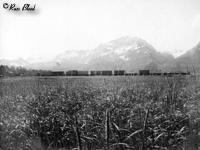 |
[Added 3/9/07] Line of flat cars with container
vans. Taken in the yard. |
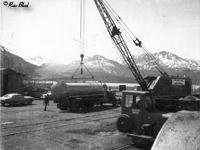 |
[Added 3/9/07] Another view of the photo sent
earlier. It shows
the switcher. 1970 |
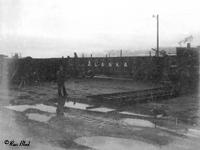 |
[Added 3/9/07] I think this is rail for the
first expansion of the yard which was across Mineral Creek Loop Road. 1969 |
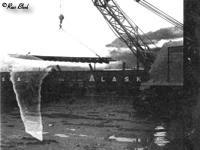 |
[Added 3/9/07] Shows new rail being handled
by crane. 1969 |
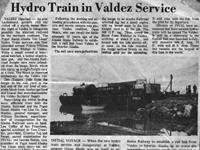 |
[Added 3/9/07] This is from the Fairbanks Daily
News Miner. |
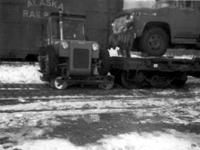 |
[Added 3/9/07] I think this was taken when
the switcher was fairly new. April 1966 |
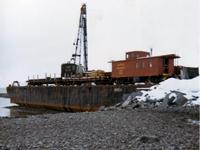 |
[Added 3/9/07] Just another view of a previous
photo. It shows the barge resting on the pad. 1966 |
[Added 9/27/13]
Lindsey Jauregui asks, "I am curious to ask about the "dolphins" (equipment of some kind) mentioned in the first photos on this page -- what exactly are they, and what are they used for?
Russ responds as follows:
How to describe a ( Mooring?) Dolphin? Simple question I thought, till I tried to detail. Don't recall trying to before and not that knowledgeable. Finally went to wikipedia and there is a good answer and picture there.
The Dolphins were important components . With this barge landing one or two hand operated winches were also used ( mounted on piling if I recall next to bulkhead ) to run wire rope to corners of barge to help keep end of barge against wood bulkhead , for track alignment and, short sections of rail to be placed in position, ( w / bolts and flanges) , to span the short space between rails on barge deck and tracks shoreside. This usually required constant monitoring to make any adjustments as tide went out , until barge was setting firmly on pad to begin work.
Cars could then be moved ashore, thru switches and positioned in yard .
There always seemed to be an awareness of working with the tides, and how much time it allowed to move cars off and on to the barge .
If I remember right, the barge needed to to be off loaded and load back completed before tide came back in enough to raise it off the pad.
Because this was tide work, many times beginning or ending , this was late at night or early morning. Always limited number of hours to complete , so priority then was cars moving on and off barge and repositioning in yard later if needed. Number of railcars inbound and outbound also varied.
Conditions and needs could also change things , along with any equipment issues.
Let me know if the dolphin info works . I think at the barge landing there was a point to attach mooring lines, on top , w/extended piling or bitt. I can't recall now if there were one or two dolphins.
Sorry for the length of reply, but thought it might add to how it worked. Hopefully it's somewhat accurate as it is a long time ago now!
BACK
Page created on 1/19/06 and last updated
9/27/13
© 2006-2013 by individual authors as noted above





















